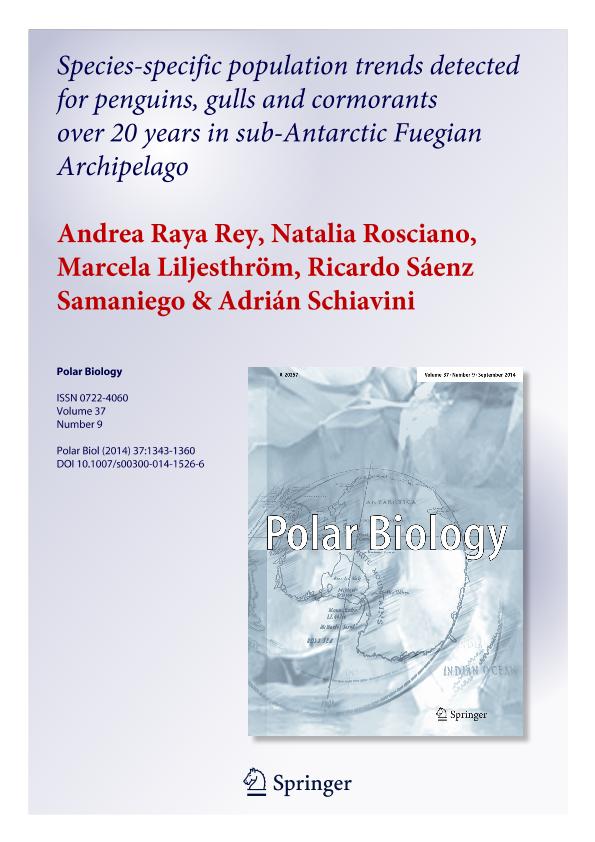Mostrar el registro sencillo del ítem
dc.contributor.author
Raya Rey, Andrea Nélida

dc.contributor.author
Rosciano, Natalia Gimena

dc.contributor.author
Liljesthrom, Marcela

dc.contributor.author
Saenz Samaniego, Ricardo Andres

dc.contributor.author
Schiavini, Adrian Carlos Miguel

dc.date.available
2016-04-29T18:14:31Z
dc.date.issued
2014-08
dc.identifier.citation
Raya Rey, Andrea Nélida; Rosciano, Natalia Gimena; Liljesthrom, Marcela; Saenz Samaniego, Ricardo Andres; Schiavini, Adrian Carlos Miguel; Species-specific population trends detected for penguins, gulls and cormorants over 20 years in sub-Antarctic Fuegian Archipelago; Springer; Polar Biology; 37; 9; 8-2014; 1343-1360
dc.identifier.issn
0722-4060
dc.identifier.uri
http://hdl.handle.net/11336/5450
dc.description.abstract
Understanding the dynamics and causes of population trends are essential for seabird conservation. Long-term studies of seabirds at high-latitude (Antarctic, sub-Antarctic and Arctic) regions have shown contrasting species-specific trends in population size in response to climate change and anthropogenic pressures. We have studied for the last 20 years (1992?2012) the population trends of seven seabird species that breed in the Beagle Channel, south-eastern Tierra del Fuego and at Staten Island, a sub-Antarctic region in southern Argentina. The numbers of Magellanic and Gentoo Penguins increased significantly since 1992 (by[15 % year-1). In comparison, the populations of Imperial Cormorants, Dolphin Gulls and Kelp Gulls increased at slower rates ( % year-1), while the Rock Cormorant population even decreased by 1.3 % year-1. At Staten Island, the numbers of Rockhopper Penguins decreased by 24 % between the censuses of 1998 and 2010, whereas the population of Magellanic Penguins increased by 227 % during the same period. Over the study period, air and sea-surface temperatures remained stable in our study area, suggesting that the detected population changes are not driven by the climate. This finding contrasts with the detected links between increasing temperature trends and seabird population changes reported from Antarctic and Arctic regions. The level of tourism and size of the permanent human population has increased in the Beagle Channel area during the last 20 years and could be responsible for the increase of gull populations. The seabird species that received the highest number of visitors (Imperial Cormorants and penguin species) seem to be adapted or at least indifferent to pressures exerted by tourism, as their populations increased during the study period. In addition, increasing numbers of seabirds in the area may generally be leading to higher abundances of scavenging species (e.g. gulls).
dc.format
application/pdf
dc.language.iso
eng
dc.publisher
Springer

dc.rights
info:eu-repo/semantics/openAccess
dc.rights.uri
https://creativecommons.org/licenses/by-nc-sa/2.5/ar/
dc.subject
Dolphin Gull
dc.subject
Kelp Gull
dc.subject
Imperial Cormorant
dc.subject
Rock Cormorant
dc.subject
Magellanic Penguin
dc.subject
Gentoo Penguin
dc.subject
Southern Rockhopper Penguin
dc.subject
Population Trends
dc.subject
Sub-Antarctic
dc.subject
Climate
dc.subject
Tourism
dc.subject.classification
Ecología

dc.subject.classification
Ciencias Biológicas

dc.subject.classification
CIENCIAS NATURALES Y EXACTAS

dc.title
Species-specific population trends detected for penguins, gulls and cormorants over 20 years in sub-Antarctic Fuegian Archipelago
dc.type
info:eu-repo/semantics/article
dc.type
info:ar-repo/semantics/artículo
dc.type
info:eu-repo/semantics/publishedVersion
dc.date.updated
2016-05-06 15:52:43.262787-03
dc.journal.volume
37
dc.journal.number
9
dc.journal.pagination
1343-1360
dc.journal.pais
Alemania

dc.journal.ciudad
Berlin
dc.description.fil
Fil: Raya Rey, Andrea Nélida. Consejo Nacional de Investigaciones Científicas y Técnicas. Centro Austral de Investigaciones Científicas; Argentina
dc.description.fil
Fil: Rosciano, Natalia Gimena. Consejo Nacional de Investigaciones Científicas y Técnicas. Centro Austral de Investigaciones Científicas; Argentina
dc.description.fil
Fil: Liljesthrom, Marcela. Consejo Nacional de Investigaciones Científicas y Técnicas. Centro Austral de Investigaciones Científicas; Argentina
dc.description.fil
Fil: Saenz Samaniego, Ricardo Andres. Consejo Nacional de Investigaciones Científicas y Técnicas. Centro Austral de Investigaciones Científicas; Argentina
dc.description.fil
Fil: Schiavini, Adrian Carlos Miguel. Consejo Nacional de Investigaciones Científicas y Técnicas. Centro Austral de Investigaciones Científicas; Argentina. Wildlife Conservation Society; Estados Unidos
dc.journal.title
Polar Biology

dc.relation.alternativeid
info:eu-repo/semantics/altIdentifier/url/http://link.springer.com/article/10.1007%2Fs00300-014-1526-6
dc.relation.alternativeid
info:eu-repo/semantics/altIdentifier/doi/10.1007/s00300-014-1526-6
dc.relation.alternativeid
info:eu-repo/semantics/altIdentifier/doi/http://dx.doi.org/10.1007/s00300-014-1526-6
Archivos asociados
